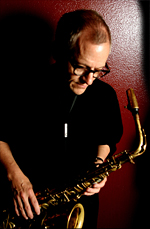 |
 |
||||||||||||||||
"LH & the CCP" Review
Honoring the great Jazz innovators of the past can be viewed as an important element to understanding the orientation of today's arists. While the music has experienced earthshaking transition, relating to its roots appearts to be irrepressible. Hughes on (this album) salutes Cannonball-Adderley and John Coltrane from the early period that spawned their onlly recorded association away from the Miles Davis bands on Cannonball Adderley Quintet in Chicago from 1959 with Wynton Kelly, Paul Chambers, and Jimmy Cobb. Rather than clone the sound and tunes of the original group, Hughes and his associates play over half the album using original compositions penned from the ink of the historic period. The colorful cover art, however, clearly shows the tie to the original product. The leader guides the way on bass, while Babad takes the alto part of Adderley and Cashman the tenor role of Coltrane. The music is highly rhythmic with heavy concentration on the up-front alto/tenor unison theme style used by Adderley bands as a gateway to the individual improvisations. Czach and Ranier alternate on piano and Kreibich takes over the drum role. Hughes executes fast paced, walking bass lines as the foundation for the happy, feel-good set. The band often introduces its own variations on the popular tunes of the honorees. "No Mercy" is an obvious reference to the soulful Adderley, and "Julian" touches base with the gospel-inspired sound of The Big Man. Interestingly, Coltrane's "Impressions" is presented the way the Adderley Quintet would have performed it. "The Old Ball and Trane" contains the strongest musical bond to the bold Adderley/Coltrane sound. "Limehouse Blues" and "Love For Sale" both bring out the familiar horn harmonic interplay as another nod and allow Cashman and Babad to strut with confidence. The album is in direct touch with the past but is dressed in shiny new clothes to preclude being considered regurgitated stuff. While the ghosts of Adderley and Coltrane clearly roam through the set, the music has enough freshness to allow it to breath on its own. | ||||||||||||||||